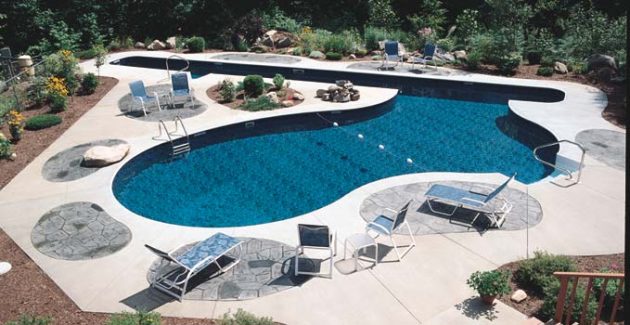If you’ve finally decided to install Inground swimming in your home, congratulations, you’ve made a great decision.
You’re about to join the growing number of people who are enjoying the sweet benefits of transforming their backyards from a boring place to an exquisite sight and site that everyone can enjoy.
Meanwhile, here are things about swimming pool installation that you must know before you get started.

Plan for Inground Swimming Pool Installation
Planning is a vital first step to almost every meaningful thing you want to do.
For swimming pool installation, you also have to plan the process from start to finish.
Here are things to do:
- Assemble a team: Installing a swimming pool cannot be done by one man, so you’ll need to get a team to work with throughout the process or you simply hire a professional swimming pool installation
- Decide what you’ll use the pool for: You don’t install in your home what wouldn’t be beneficial to you. So, you have to ask yourself why you want a swimming pool in your home. Is it for entertaining your family, for anesthetics, or a resale? This decision will influence the design you’ll bring to the team that will install the swimming pool.
- Check out the regional codes and restrictions: Different regions have restrictions regarding pool installation. California, for instance, requires that your pool is at least 5 feet from your property line.
- Make good use of your space: Don’t let the shape of your yard deter you from installing a pool in your backyard. If possible, tighten up your greenery to accommodate a swimming pool.
- Begin your plan on time: Planning could take a month or two, so it’s better to begin it on time before you grow cold feet on the whole idea.
The Best Time to Install a Pool
Installing a swimming pool will involve excavation and the actual installation.
To break the ground of a pool you want to be ready for summer, spring is the best time to get started. However, flooding may be a challenge if you live in a rainy area.
For the installation process, fall is a great season to get started because the weather is steadier.
Winter is the only time that installing a swimming pool is not ideal, especially if you reside in the north. During winter, the ground will be frozen, making digging very difficult.
Types of Inground Pool to Choose From
There are four different kinds of Inground pool to choose from:
1. Concrete Swimming Pool
Just like its name, this kind of swimming pool is made from concrete. To make it, you first dig the ground for the pool and build a steel framework. Afterward, you pour concrete and seal it with plaster. Recently, people are using alternative kinds of finishing like pebble and tiles on the concrete pool. The advantage of a concrete pool is that it can last for a very long time. The disadvantage, however, is that it is expensive and takes a lot of manpower to build one.
2. Fiberglass Swimming Pool
Fiberglass pools come in a single piece, already made and ready for installation. The name is derived from the material it’s made from – fiberglass. This kind of pool is unique compared to concrete or vinyl liner in the sense that it is made entirely from one material, fiberglass. Fiberglass packs a great advantage in the short timeframe it takes to get installed. It takes at most six weeks to completely install one. A major disadvantage of fiberglass is that it isn’t easily customizable. There is a restriction on the size of the pool due to the laws governing the transportation of this kind of pool on the highway.
3. Vinyl Liner Swimming Pool
Vinyl liner swimming pool, like fiberglass pool, comes already made. You don’t build it from the scratch like the concrete swimming pool. Vinyl liner pool comprises wall panels that can either be made of steel, aluminum, or plastic; a pool base; vinyl liner; steps that can either be plastic or lined with vinyl and coping. This kind of pool can last up to nine years after which you can replace it. The good thing is that replacing a vinyl liner swimming pool isn’t so expensive. The disadvantage of a vinyl liner pool is that it is not as durable as the liners are usually less than a millimeter in thickness.
The Cost of Installing a Swimming Pool
The cost of installing a swimming pool isn’t fixed. It varies by the area you live, the soil conditions, the water circulation system, the pool type, and the size of the swimming pool.
Also, the price can vary based on the period of the year you’re installing it. Some swimming pool installation contractors give you a discount when you install your pool when it’s not the season for building pools or when they have very few orders.
Now, based on the type of pool you choose, concrete pools will cost you the most. Vinyl-lined swimming pools are the next most expensive, followed by fiberglass.
However, certain kinds of fiberglass pools can be more expensive than concrete swimming pools. A high-quality fiberglass pool is very pricey.
On average, concrete swimming pool projects will cost between $50,000 and $100,000. Fiberglass will cost around $45,000 to $85,000, and vinyl liner packages will cost between $35,000 and $65,000.
The Next Step…
Would you prefer to gather a team of friends to plan and install your pool or you’d rather an experienced swimming pool installation contraction do the job?
Peoria Swimming Pool Pros are the best in the business of pool installation. We offer cost-friendly prices and assist you in selecting, designing, and installing the pool of your dreams. Call us now on (913) 0090 – 112 to get a free quote.














